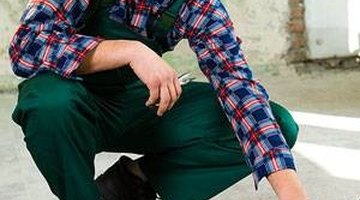How Does a Staple Gun Work?
The staple gun is a powerful tool that is quite overlooked until you need one, for nothing puts things together with such ease. They can be heavy-duty tools such as the ones used in construction to apply roofing materials, secure insulation, hold wiring in place and install carpeting.

Staple Guns Explained

Serious crafters depend on them for upholstering, creating home decor items and fastening everything from picture frames to cornice boards.
The following article will help you to understand the different types of staple guns, how they work and the safety measures you should take when using them.
Manual Staple Guns

Manual staple guns operate on "you" power. The simplest of all staplers, they store and fire a staple off as you press the trigger, using the energy of a spring. Portable and relatively safe, the squeeze mechanism lifts a plunger --- the staple piston --- to engage bent tension bars, which slip off hooks and onto a loader, snapping the firing piston and sending out a staple.
This type of stapler is different from an office-type stapler in that it does not fold the wire ends of the staple inward, but shoots the sharp ends into the target material.
Power Staple Gun Types and Functions

The other two types of staple gun are operated by electricity or batteries, or they function with the aid of compressed air. Their advantage is the ability to work on heavy-duty applications for a long time with moderately little physical exhaustion. Two types of triggers exist: the sequential mode and the bump mode, which refers to the trigger device used.
On the sequential mode model---also referred to as a restrictive trigger---a nail is sent out and the trigger must be released in order to insert the next nail. This selection of staple gun ensures that there will be no double fire or second staple coming out if accidentally bumped.
The procedure is slower than its neighbor gun however, the bump mode model. The bump trigger---also called the dual action trigger---is rapid fire, dispensing a nail by repeatedly bumping the gun against the surface, while holding down the trigger.
They use expanding gas to push the staple out of the gun, (very much like a real gun,) except that there is no powder to ignite as with a weapon, just compressed propellant gas, activated by pistons reacting to a gas-powered air compressor.
Risks and Hazards

Whether you are using the gun to shoot staples or nails, the Occupational Safety and Health Administration (OSHA) wants you to treat them as real guns, capable of serious injury.
Tip: • Place hands on the body, handle and trigger surfaces only, never near the dispensing area.
Warning: • Nailing one nail into another can create ricochet mishaps, beware of depressing the trigger unknowingly. • Don't use or store where children can get access. • Engage the safety lock when not in use. • Treat all tools of this type as you would a weapon, and don't point it at anyone.
The Drip Cap
- The staple gun is a powerful tool that is quite overlooked until you need one, for nothing puts things together with such ease.
- They can be heavy-duty tools such as the ones used in construction to apply roofing materials, secure insulation, hold wiring in place and install carpeting.
- The simplest of all staplers, they store and fire a staple off as you press the trigger, using the energy of a spring.
- Two types of triggers exist: the sequential mode and the bump mode, which refers to the trigger device used.
- amp;#x2022; Engage the safety lock when not in use.
- &
Resources
Writer Bio
Andrea Campbell is the author of 12 nonfiction books on a variety of topics. She is also an e-instructor, editor and columnist who has been writing professionally since 1991. Campbell, the daughter of a builder, writes frequently about home improvement. She uses her degree in criminal justice to write about forensic science and criminal law.
Photo Credits
- Clipart.com
- Clipart.com
More Articles



